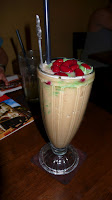Seemingly every alleyway Pulau Penang's historic capital, Georgetown, leads to a surprise
The Cameron Highlands was a parking lot!
I cannot in good conscience recommend that anyone go to the Cameron Highlands at this point, either from either a tourism or environmental standpoint. The landscape is being completely ravaged by over-development, and (as usual) the marketing people are way ahead of the infrastructure. I haven't seen traffic jams of such severity since leaving Atlanta, hundreds of cars packed with people sitting at a standstill on two-lane mountain roads. The rainforest is disappearing at a rapid rate to make room for hotels and farms. Because the climate is cooler, the Highlands are a magnet for city dwellers who visit during holidays and weekends. Ironically, the deforestation is resulting in warmer trends and other associated problems such as pollution from farm run-off.
The Cameron Highlands wasn't all bad - the BOH Tea Plantations are a beautiful place to visit and away from all the traffic and chaos that plagues the main town centers.
The CH landscape and lush rainforest that remains is quite spectacular, but there seems to be no interest in either preserving it or providing (free) information or basic facilities to enable people to see it. Most visitors to CH seem to want to sit in air-con buses and get out occasionally to eat strawberry ice cream. Seriously. For those who are seeking a nature experience, it's still possible, but it will take effort and you need to be willing to get well off the beaten path. You'll also need to have decent outdoor skills. Walking trails were in poor condition (I can't tell you how many fallen trees we had to climb over during one of our walks), the maps are very poor and lack even the most basic details about distances or difficulty, and signs of any kind were almost non-existent. If you wanted more information, it didn't seem to exist in printed form (though later I found some decent track descriptions on the web).
In CH, we "discovered" the Malaysian Breakfast of champions: Roti with Teh (tea) Tarik!
The world's largest flower, Rafflesia, is found in the Highlands and we really wanted to see it, but the tours were quite expensive. When I inquired about finding one on our own (assuming we were willing to get there ourselves) a tour agent replied that the nearest ones were some 40 km away. He explained that sometimes other tour companies were known to intentionally destroy any flowers that should bloom closer to towns or on public trails so that people cannot see them without booking a tour. To his credit, he then explained that this was the reason that his company didn't offer tours to see the flower. Nature tourism should provide economic benefits to the local population, but not like that. It was sad, really, and surprising (I don't know why – by now we should be used to it, right?) to see such short-sightedness. If there had been more opportunities / information provided, we might have stayed longer (resulting in more money for the hotel, local restaurants, etc.) but as it was we were ready to go after two days.
The entrance to Fort Corwallis in Georgetown, Pulau Penang - just one of many, many historic sites on the island
On the other end of the 'visitor experience spectrum' was Pulau Penang, or more specifically, historic Georgetown, the largest city on the island. Here was a place that 'got it' and you could tell they cared about both the community and their visitors. They must be doing something right – in 2009, Pulau Penang was named #2 of 44 must-see destinations around the world by the NY Times. Georgetown (along with Malacca) is designated a World Heritage Site in recognition of its outstanding cultural, historical and architectural splendors. In many ways, the two cities are quite similar, both being important ports of call for traders and colonial powers for the past 500 years (and earlier), but Georgetown is notably larger and more vibrant (and busier) than Malacca.
Georgetown's City Hall, a lit up at night
Chinese Clan Houses (and rickshaw cyclos!) are EVERYWHERE in Penang
The AMAZING Chinese Clanhouse of the Khoo Khongsi. Words and this pic simply can't describe this building, which is said to have rivaled the Emperor's palace in China. I so badly wanted to move the piece-o-crap car out of my photo!!! This building was featured in the 1999 film "Anna and the King" starring Jodie Foster.
Kek Lok Si, a Buddhist temple complex on the west side of the island, featured beautiful temples and a gigantic 30.2 meter tall bronze statue of the Kuan Yin
I really can't say enough good things about this place - we had such a good time there and could have spent another week exploring Pulau Penang's hidden gems. As if the central city offerings weren't enough, there are also many points of interest around the larger island that are worth seeing. The public bus system is excellent (new air-con buses, awesome printed schedules, and even a free town belt bus!) and we used it to visit Balik Pulau, a town on the far west side of the island, as well as the Botanic Gardens and Kek Lok Si, an enormous Buddhist Temple (Kek Lok Si). Great fun, and there was still plenty more to do in the region that we didn't have time for.
Kuala Lumpur's iconic Petronas Towers, until 2004 the world's tallest buildings
Next stop: Hanoi, Vietnam











































